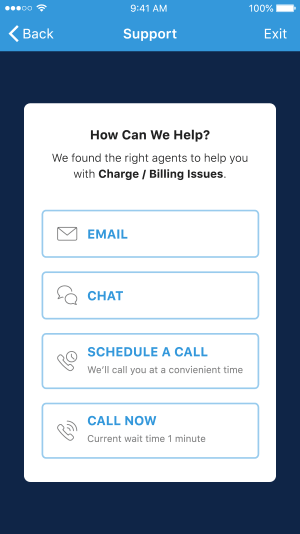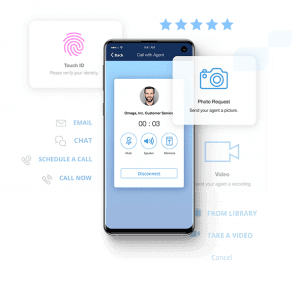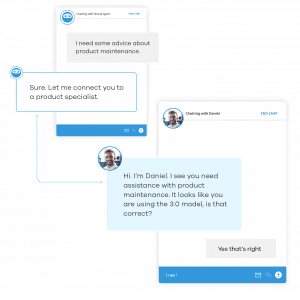Stay updated!
The best customer experience content delivered right to your inbox.
Building an Intelligent IVR for More Predictive, Contextual, and Conversational CX
by Hayden Lee |
The IVR isn’t a topic that gets enough coverage. We gravitate to the shinier objects and tend to focus more on the agent experience, omnichannel, and artificial intelligence. Meanwhile, your IVR can be one of the biggest drivers of good vs bad CX. The IVR is often the reason customers start yelling and screaming before ever talking to an agent, and more often than not it’s the reason that most conversations start with frustrated customers and flustered agents. When it comes to your customer experience, it’s not just about how well trained or equipped your agents are or the products and services you provide. It’s the end to end customer journey that matters. And the IVR is at the heart of that journey.
IVRs have evolved considerably over the last 30 some years, but, before jumping straight into the latest technology, we first need to address how the customers who are interacting with these IVRs have also evolved. Simply bolting new technologies onto a legacy system or a more modern cloud-based system is never the solution. You first need to consider how the users behavior has changed to maximize the impact of any technology investments and improve the overall CX.
Changes in Consumer Behaviors
Own a smartphone
5hrs / day
Avg time spent on our phones
Consumers have evolved. Both in terms of how we interact with each other, but also the way in which we interact and engage with a company or an organization. What’s changed? Almost 15 years ago Apple introduced the first iPhone and ever since then we have steadily been replacing landline phones, cellphones, and desktop computers with a single device, the smartphone. Today, we see smartphones in the hands of over 80% of consumers, we spend on average more than 5hrs / day on our phones. So the saying “meet your customers where they are” has always referred to the channel they were in. Today, I think it should instead refer to what mode they’re in and what device they’re on when using those channels. The voice and digital experience have effectively converged into a single experience, on a single device that fits into the palm of our hand. So as we think about modernizing our IVR experience and the technologies at our disposal, we have to stop thinking in terms of channels, and instead think through the lens of this new smartphone era consumer and the converged voice and digital experience they’re expecting. We have to expand on the traditional definition of what an IVR does and where it’s used.
The second significant change to consumer behavior is a little more recent. When the pandemic first started, contact center operators were scrambling to support agents working from home. We accelerated multi-year digital transformation initiatives down into a couple of weeks. Huge investments were made ensuring agents had secure and remote access to the systems and tools they needed to do their job. But, contact centers aren’t the only ones who scrambled and agents aren’t the only ones who have become remote. Businesses of all kinds made huge changes to their business models, and as a result the average consumer is now remote as well. We can order groceries online and have them delivered to our doorstep, or get curbside pickup at just about any brick and mortar store to avoid wait times and lines. We’ve got tele-medicine, tele-banking, tele-justice, tele-schooling, and tele-commuting. The list goes on. The pandemic has shown us some obvious downsides, but also some upsides of a more digital and more remote life. According to Pew research, more than 50% of people will continue to seek out some of these new convenience-based services long after the pandemic is over. Brand loyalty is changing. It isn’t just about product quality, reputation, or price. It’s about the service you provide and the availability of that service. More than ever, consumers are seeking out and gravitating toward companies that can offer these frictionless experiences and convenience.
So that’s it. Consumers today spend more time on their smartphone and they yearn for convenience. This is what we need to consider as we think about overhauling and modernizing our IVR systems.
Modernizing Your IVR
So now let’s look at ways to drive meaningful improvement to the customer experience simply by rethinking the utility of the IVR. Let’s walk through various use cases and the outcomes they drive. As you think about how and where to invest for your contact center, it’s important to think of these not as ‘either or’ technology strategies, but rather complimentary layers to one another. Each layer provides a different benefit, and furthers that concept of a converged voice & digital experience, as well as a more modern, personalized, and contextual experience for your customers. As you add new layers, the purpose and utility of your IVR will transform. We will evolve away from the basic touch tone or DTMF based question and response system for the purpose of routing. The next evolution of IVR is a more dynamic, conversational, and intelligent system that will guide the customer throughout their journey. We won’t just guide them to the right agent:
- We’ll guide them to the right channel.
- We’ll guide them to answers for more self-servicing and deflection.
- We’ll guide them through a more natural and efficient means of explaining their issue.
- We’ll even guide administrators of the IVR to measure and dynamically tune performance.
For well over a decade, the contact center industry has been putting an overwhelming amount of emphasis on the promise of Omnichannel, which is all about lessening the pain of consumers switching channels. Meanwhile, we’ve completely ignored the fact that customers are switching channels because the channels have been deployed in silos and without consideration for the smartphone. As a result, the customer journey is more fragmented than ever as we drive more and more customers to our mobile or in app experience. Take for example what happens when a customer clicks “Contact Us” from within the mobile app. If they click the 1-800 number or “Call Now”, they get kicked out of the app and into their phone dialer screen. If they click “Chat Now”, most often they get kicked out of the app and into a browser-based chat session. When that happens, we lose all context of what the customer was doing in the app prior to initiating a conversation.
To provide a truly channelless experience, we should start by providing a common IVR experience across voice and digital channels that starts from the smartphone to extend to the mobile and in-app experience.
Digital IVR
 The first layer to help us achieve this converged experience is a digital IVR. On its own, the digital IVR or what we’ve traditionally thought of as a visual IVR is not something new, but we use it as a bridge from the smartphone to the contact center through any channel, creating a more seamless customer journey.
The first layer to help us achieve this converged experience is a digital IVR. On its own, the digital IVR or what we’ve traditionally thought of as a visual IVR is not something new, but we use it as a bridge from the smartphone to the contact center through any channel, creating a more seamless customer journey.
A digital IVR provides a more natural and more efficient means of getting customers where they need to go, using visual and touch driven menus. Again, we’re not just using this for the purpose of routing. We can actually use the digital IVR to guide and steer customers to the optimal channel based on agent availability and wait times, offer them call back options, and even effectively guide them into self-servicing options. This will resolve issues faster, and it helps the contact center balance volumes across channels, keep SLAs in check, and will significantly reduce the customer frustration linked to the robotic IVR voice prompts.
Aside from the customer benefits of a more efficient and natural way of traversing the IVR, we can now start to personalize and contextualize the interaction because we didn’t start from a raw phone call with no history. We’ve remained in the app where we have all kinds of information about the user – what they were looking for in the app before they clicked “Contact Us”, as well as access to a goldmine of diagnostic data from the app and the smartphone that can help agents see and assess the problem right away. Because we’ve used the digital IVR as a bridge to the contact center while keeping the customer in-app, we’re now in a unique position to start leveraging other smartphone technology to make the conversation more efficient and productive. We don’t have to ask for maiden names and addresses to verify identity. Customers can authenticate using the face id, fingerprint, or passcode verification – whatever is already natively setup on their phone. We can share digital information such as photos and videos back and forth. By blending these voice and digital experiences together, we can virtually eliminate the need to switch channels and customers repeating their issue.
Intelligent Automation
 As contact center leaders, if you haven’t started already, chances are you’ll soon start thinking about how and where to invest in AI technology. When it comes to the IVR, there are several AI solutions out there for consideration, some of which we’ll touch on. We’d consider a lot of these to be AI point solutions like chat bots that get added onto existing IVR systems, and there can be considerable cost associated with these. These solutions can be expensive to procure, and they require ongoing investments to tune and maintain over time. If you’re looking at AI for the right reasons, like automation that drives cost savings or intelligence to drive better outcomes, then there are other ways to achieve those results without having to make any additional investments.
As contact center leaders, if you haven’t started already, chances are you’ll soon start thinking about how and where to invest in AI technology. When it comes to the IVR, there are several AI solutions out there for consideration, some of which we’ll touch on. We’d consider a lot of these to be AI point solutions like chat bots that get added onto existing IVR systems, and there can be considerable cost associated with these. These solutions can be expensive to procure, and they require ongoing investments to tune and maintain over time. If you’re looking at AI for the right reasons, like automation that drives cost savings or intelligence to drive better outcomes, then there are other ways to achieve those results without having to make any additional investments.
The IVR isn’t just a tool for routing customers. It should be a tool to orchestrate the customer journey and guide them – which involves:
- Channel steering
- Identity verification
- Providing a means of self-service
- Gathering contextual information for the agent
This is what the IVR should be doing. Collectively this not only makes the IVR experience and hold times productive, but it allows the agent to jump straight into the issue rather than starting the conversation with the usual “Who am I speaking with and how can I help you?” This is the type of frictionless and personalized experiences your customers are seeking out.
By implementing this type of intelligent automation, you’re modernizing your IVR experience, and overhauling the voice experience at the same time. Implementing this will:
- Drive down conversation time.
- Increase your rate of FCR.
- Make agents more efficient and productive.
There’s a huge opportunity to drive up your CX here without any incremental investments in separate AI point solutions.
Conversational AI & Virtual Agents
Now, when it comes to conversational AI and virtual agents, you can drive significant growth in 3 key areas:
 You can reduce the time customers spend in the IVR and the frustration associated with robotic voice prompts by using AI-powered conversational and intent based routing. For example,Virtual Agent- “How can I help you?”Customer- “I want to talk to someone about a problem I’m having with my order.”The virtual agent can understand the language, the intent, and can route accordingly.
You can reduce the time customers spend in the IVR and the frustration associated with robotic voice prompts by using AI-powered conversational and intent based routing. For example,Virtual Agent- “How can I help you?”Customer- “I want to talk to someone about a problem I’m having with my order.”The virtual agent can understand the language, the intent, and can route accordingly.- You can deflect inbound conversations from hitting agents, provide broader coverage and hours of operation, and flatten out some of those big peaks in service volumes by offering customers more self-service capabilities. If your agents are handling a lot of routine tasks – things like scheduling appointments, checking balance inquiries, order status, or processing payments.- These are great use cases to offload to virtual agents so your live agents get that time back to focus on the more critical and complex issues.
- The most effective use of virtual agents is when they’re teamed with the human agent, both of them taking on different roles but working together throughout the customer journey. Here, the virtual agent is more than just a conversational-based routing tool, it’s working to gather contextual data for the agent, setting up the conversation in advance so the live agent can quickly jump straight into the issue, resolve it, and move on the next. In some cases, the virtual agent will be able to resolve the issue on its own. Sentiment and intent should be monitored to know when it’s time to conference an agent in. You should also use data from your CRM to dynamically determine if maybe based on information in the customer profile or previous interaction history there are clues suggesting that we bypass the virtual agent and route instead to a live agent to yield a better outcome. Once an agent is brought into the conversation, they work together. The live agent compliments the virtual agent with a higher emotional intelligence. The virtual agent is using its processing power and ability to understand intent to surface helpful content to the agent such as knowledge articles and provide them with turn-by-turn guidance to yield the best possible outcome. The agent can even hand the conversation back to the virtual agent to wrap up the call, process payments, complete an application, and schedule a follow-up call – increasing the efficiency and virtual footprint of your contact center.
Flow Analytics
Up to this point, we’ve talked about a couple of very impactful ways to transform your IVR experience from a tool used primarily for routing to an intelligent system for guiding and orchestrating the customer journey. While we have no shortage of reports and dashboards at our disposal that will show us how the KPIs are trending, you need to be able to drill into the metrics to understand what’s driving them up or down. To do this and to truly understand the journey that your customers take, you need a journey mapping tool or what we refer to as Flow Analytics. These sankey diagrams will track every step your customers take in your IVR to help you optimize queue structures, menu design, and also help you identify bottlenecks, points of drop off, and abandons. Flow analytics is also a great way to test theories and ideas in production on a smaller scale, and measure the outcomes before making holistic changes to your IVR.
Sitting at the heart of the customer journey, the IVR can make one of the biggest impacts when it comes to driving better customer and agent experiences. To maximize the impact of any incremental technology investments though, we must transcend the omnichannel imperative and design new workflows for the more modern smartphone era consumer. By layering in technology capabilities on a more modern and agile foundation, we can successfully transform the utility of the IVR from a basic tool for routing to a journey orchestration engine for a more personalized, contextual, and conversational CX.
Learn more about building an intelligent IVR by listening to our most recent webinar:
The best customer experience content delivered right to your inbox.